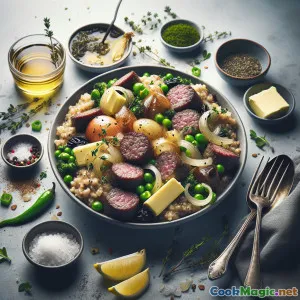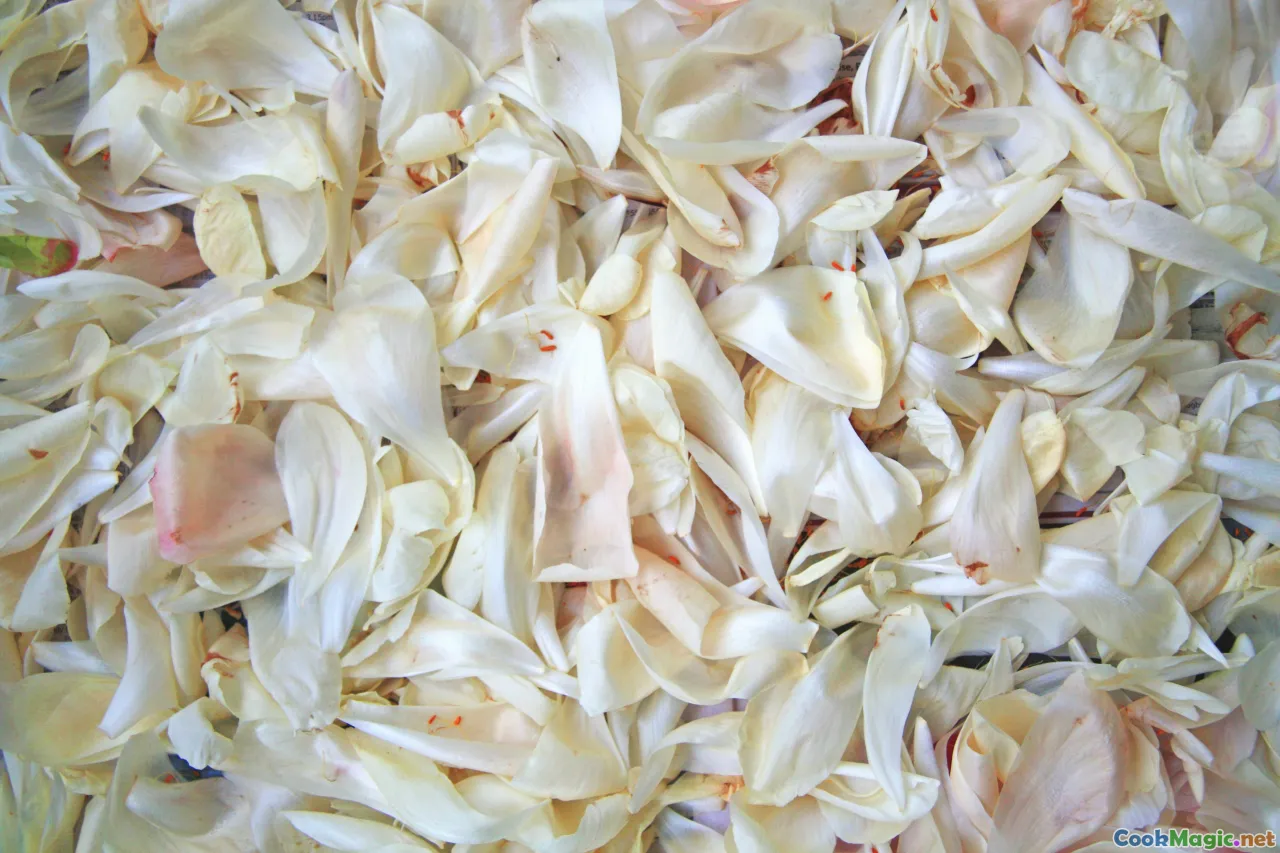
Buttriges schottisches Skirlie mit Zwiebeln und Haferflocken
(Buttery Scottish Skirlie with Onions and Oats)
(0 Bewertungen)0
389
November 08, 2025
Problem melden
Zutaten
-
200 grams Pinhead (stahlgeschnittene Haferflocken)
(Medium oatmeal works; rolled oats yield a softer texture)
-
60 grams Ungesalzene Butter
(For richer flavor; use vegan butter to make it dairy-free)
-
20 grams Rinderfett (oder Schmaltz)
(Traditional depth; omit for vegetarian version)
-
2 medium Gelbe Zwiebeln fein gehackt
(About 300g total, diced small for even cooking)
-
1 clove Knoblauchzehe, fein gehackt
(Not traditional but adds warmth)
-
1 tsp Frische Thymianblätter
(Or 1/2 tsp dried thyme)
-
1 tsp Meersalz
(Adjust to taste, especially if using stock)
-
0.5 tsp Frisch gemahlener schwarzer Pfeffer
(Coarse grind preferred)
-
120 ml Gemüse- oder Hühnchenbrühe
(Add gradually, only if mixture seems dry)
-
2 tbsp Glattblättrige Petersilie, gehackt
(Fresh finish and color)
-
1 tsp Zitronenschale, fein gerieben
(Brightens the richness)
-
1 tbsp Schottischer Whisky
(Off-heat; aromatic, optional flourish)
(Medium oatmeal works; rolled oats yield a softer texture)
(For richer flavor; use vegan butter to make it dairy-free)
(Traditional depth; omit for vegetarian version)
(About 300g total, diced small for even cooking)
(Not traditional but adds warmth)
(Or 1/2 tsp dried thyme)
(Adjust to taste, especially if using stock)
(Coarse grind preferred)
(Add gradually, only if mixture seems dry)
(Fresh finish and color)
(Brightens the richness)
(Off-heat; aromatic, optional flourish)
Nährwerte
- Portionen: 4
- Portionsgröße: 1 scoop (150g)
- Calories: 1440 kcal
- Carbohydrates: 136 g
- Protein: 28 g
- Fat: 82 g
- Fiber: 21 g
- Sugar: 8 g
- Sodium: 2600 mg
- Cholesterol: 150 mg
- Calcium: 180 mg
- Iron: 9.2 mg
Anweisungen
-
1 - Toast the Oats:
Place a heavy skillet over medium heat. Add the dry pinhead oatmeal and toast, stirring frequently, until fragrant and lightly nutty, 4–6 minutes. Tip oats to a bowl.
-
2 - Sweat the onions in fat:
Return the skillet to medium-low heat. Melt the butter with the beef dripping (if using). Add the chopped onions and a pinch of salt. Cook gently, stirring often, until translucent and sweet without browning.
-
3 - Add Aromatics:
Stir in the garlic and thyme. Cook 1–2 minutes until fragrant. Season with black pepper.
-
4 - Fold in oats and fry:
Add the toasted oats back to the pan. Stir well to coat every grain with the buttery onions. Fry, stirring and pressing lightly, until the oats drink up the fat and start to crisp at the edges.
-
5 - Adjust moisture and finish:
If the mixture seems dry, splash in hot stock a tablespoon at a time, just to loosen. Off the heat, stir through parsley and lemon zest. If using whisky, add and quickly stir.
-
6 - Rest and Serve:
Taste and adjust salt and pepper. Let the skirlie rest for 2 minutes to set, then fluff with a fork. Serve alongside roast meats, haggis, or sautéed mushrooms.
Place a heavy skillet over medium heat. Add the dry pinhead oatmeal and toast, stirring frequently, until fragrant and lightly nutty, 4–6 minutes. Tip oats to a bowl.
Return the skillet to medium-low heat. Melt the butter with the beef dripping (if using). Add the chopped onions and a pinch of salt. Cook gently, stirring often, until translucent and sweet without browning.
Stir in the garlic and thyme. Cook 1–2 minutes until fragrant. Season with black pepper.
Add the toasted oats back to the pan. Stir well to coat every grain with the buttery onions. Fry, stirring and pressing lightly, until the oats drink up the fat and start to crisp at the edges.
If the mixture seems dry, splash in hot stock a tablespoon at a time, just to loosen. Off the heat, stir through parsley and lemon zest. If using whisky, add and quickly stir.
Taste and adjust salt and pepper. Let the skirlie rest for 2 minutes to set, then fluff with a fork. Serve alongside roast meats, haggis, or sautéed mushrooms.
Mehr über: Buttriges schottisches Skirlie mit Zwiebeln und Haferflocken
What is Skirlie?
Skirlie is a humble yet captivating Scottish side dish made by frying oats with onions in rich fat until the grains turn aromatic, nubbly, and lightly crisp. Think of it as Scotland’s answer to a savory granola for dinner: toasty, buttery, and irresistibly nutty. Traditionally, skirlie accompanies roast chicken, beef, or game and is famously spooned alongside haggis, neeps, and tatties during Burns Suppers. It doubles as a rustic stuffing, too—simply moisten a little more and pack into a bird or bake in a small dish to serve golden and fragrant at the table.
Why this version works
- Layered fat equals layered flavor. Using butter for sweetness and optional beef dripping for depth mirrors the old farmhouse approach that prized thrift and taste in equal measure.
- Toast-first technique. Pre-toasting pinhead (steel-cut) oats boosts their nutty aroma and keeps the final texture lively rather than stodgy.
- Controlled moisture. A splash or two of hot stock keeps the oats tender without turning them mushy. The goal is cohesive, spoonable grains with delicate crisp edges.
- Bright finish. Parsley and lemon zest lift the richness, while a flick of Scotch whisky (off-heat) adds a perfumed, malty flourish.
Ingredient notes
- Oats: Pinhead or steel-cut oats are ideal for chew and structure. Medium oatmeal also works well; rolled oats will produce a softer, more cohesive skirlie—still tasty but less toothsome.
- Fat: Butter is classic and accessible. Beef dripping or schmaltz adds savory depth. For a vegetarian or dairy-free route, use olive oil or a good vegan butter.
- Onion: Finely chopping encourages even cooking and gentle sweetness. A patient, low heat prevents browning, which would shift the flavor from sweet to sharp.
- Herbs and aromatics: Thyme is subtle and woodsy. Garlic isn’t strictly traditional, but one small clove warmly rounds the profile. Parsley and lemon zest add a fresh finish.
Tips and techniques
- Heat management: Keep the onions on low heat to develop sweetness without color. Once the oats return to the pan, you can increase to medium to encourage a light crisp.
- Texture control: If you prefer fluffier skirlie, add a few extra tablespoons of stock and cover for a minute to steam. For crisper bits, leave the pan uncovered and stir just occasionally to allow some browning.
- Season like a pro: Oats are mild, so salt judiciously. If you’ve used a salty stock, taste before adding the full teaspoon of salt.
- Pan choice: A well-seasoned cast iron skillet provides even heat and gentle browning. Stainless works well too; nonstick is fine but offers less caramelization.
Serving suggestions
- Classic plate: Serve with roast chicken, gravy, and buttered greens.
- Burns Night: Spoon beside haggis, mashed swede (neeps), and potatoes (tatties) for a proud Scottish spread.
- Vegetarian delight: Crown with sautéed mushrooms finished with thyme and a splash of sherry vinegar.
- Breakfast twist: Top warm skirlie with a fried egg and a few pickled onions for contrast.
Make-ahead and storage
Skirlie keeps gracefully. Refrigerate leftovers in an airtight container for up to 4 days. Reheat in a skillet with a teaspoon of butter or oil to revive the crisp edges, or warm gently in the microwave and finish with a quick pan-toss for texture. It also freezes surprisingly well for up to one month; thaw overnight and re-crisp in a pan.
Variations
- Barley skirlie: Swap in quick-cooking barley grits for a deeper grain flavor.
- Green skirlie: Fold in a handful of finely shredded kale or cabbage during the last few minutes for color and nutrients.
- Peppery skirlie: Add white pepper and a pinch of mustard powder for a gentle bite.
- Nutty lift: Toast a tablespoon of chopped hazelnuts or walnuts with the oats for extra texture.
Cultural notes
Skirlie is a testament to Scottish frugality and ingenuity—fields of oats, a pantry onion, and a small knob of saved dripping gave families warmth and calories through cool seasons. It’s less a fixed recipe and more a method; households historically adapted it to what was on hand. That’s why today you’ll see rich festive versions with dripping and herbs, and weekday versions that are purely butter-and-onion simple. Its place next to haggis is both practical and symbolic: hearty grains and aromatics to complement the spiced offal pudding, all rooted in the land’s staples.
Common pitfalls and how to avoid them
- Soggy skirlie: Too much liquid or adding stock too early. Start dry, then moisten only if needed and only by tablespoons.
- Bland results: Under-salting is the usual culprit. Taste after toasting and seasoning; oats can absorb more salt than you expect.
- Greasy finish: If the oats don’t fully absorb the fat, fry a minute longer. The grains should glisten, not pool with butter.
Sustainability and sourcing
Choose local oats if possible—they’re hardy crops requiring less water than many grains. Rendered dripping from a roast you’re already making is a sensible way to respect the entire animal, though butter or plant-based fats are excellent alternatives.
Personal note
This skirlie leans traditional but keeps an eye on balance: rich yet bright, rustic yet polished. It’s the dish I turn to when a roast needs a companion or when I want an inexpensive, comforting bowl that tastes of hearth and home. The moment the oats hit the buttery onions, their toastiness rises like a promise—simple ingredients, well-treated, can be extraordinary.

























